For more than two decades, nuclear debates had vanished from the heart of Western strategic debates. The general perception within the Alliance was that NATO was not facing direct threats on its territory and borders. NATO was surrounded by multiple “partners”, many of which were aspiring to membership. The threat of nuclear weapons seemed remote, and debates focused on the risks of proliferation or the prospects of a world free of nuclear weapons.
This situation has changed dramatically in the last few years. Major and regional powers are modernising their nuclear forces and giving them a central role in their broader strategic posture. In such a context, deterrence is back and NATO needs to re-establish a robust and credible defence and deterrent vis-à-vis multiple and diverse threats, a topic which will be high on the agenda at NATO’s summit in Warsaw in early July. There is a strong nuclear component to this debate
Changes in the security context
In the East, events in Ukraine and the new posture of Russia challenge the very foundations of European security. For the first time since the end of the Cold War, NATO’s defence and deterrence posture could be tested – and is to a large extent already being tested – by Russian moves. It is all the more concerning that Russia has developed hybrid tactics that might prove more difficult to deter than traditional warfare. Furthermore, Russia has been exercising and using the whole spectrum of non-military and military tools, ranging from cyber attacks, proxies, special forces, and conventional capabilities to implicit or explicit nuclear threats including at an early stage in a crisis.
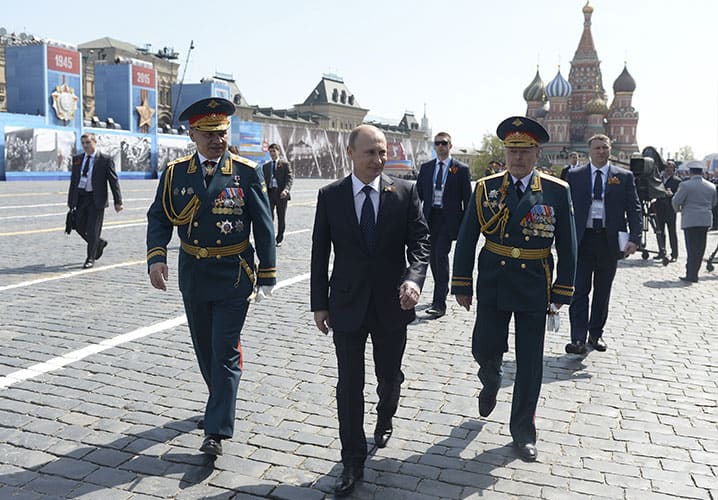
Russian President Vladimir Putin (C), Defence Minister Sergei Shoigu (L) and Colonel-General Oleg Salyukov walk together after the Victory Day parade at the Red Square in Moscow, Russia, on 9 May 2015, which served to showcase new military hardware at a time when relations with the West have hit lows not seen since the Cold War. © REUTERS/Host Photo Agency/RIA Novosti
Russia has been successfully pursuing a policy of “aggressive sanctuarization” with a significant nuclear component, under which it does not hesitate to use conventional force and nuclear rhetoric to deter external involvement countering its aggressive behaviour in its immediate neighbourhood or beyond. In practice, Russia has developed an integrated defence posture, combining nuclear and conventional capabilities in its doctrine, training and exercises.
Beyond Russian nuclear policy, it is important for the Alliance to take into account ongoing missile and nuclear proliferation risks in the Middle East, nuclear arms race phenomena in Asia, which could all alter the Alliance security. All these development suggest that the 21st century might prove more nuclear than expected. Furthermore, the policies of newcomers as well as those of some of the established nuclear weapon states demonstrate that the risk of use cannot be ruled out and that it is essential to preserve the logic of deterrence.
The review and fostering of NATO’s deterrence and defence posture has already started and has been given a significant impetus since the Wales Summit and in the run up to the Warsaw Summit. Beyond the Readiness Action Plan, it remains however extremely important to deliver the appropriate messages on the full spectrum of NATO capabilities, as deterrence can no longer be taken for granted, to address challenges both from the East and elsewhere.
The nuclear component of NATO’s posture in the 21st century
Over the last two decades, the nuclear component of NATO’s deterrence posture has been in the shadows. Debates within the Alliance have largely focused on the disarmament side of the nuclear debate, which has risked losing sight of the core purpose of the Alliance’s nuclear capabilities. For the Alliance, nuclear weapons play a unique and specific role in its deterrence posture. Their role is to prevent major war, not to wage wars.
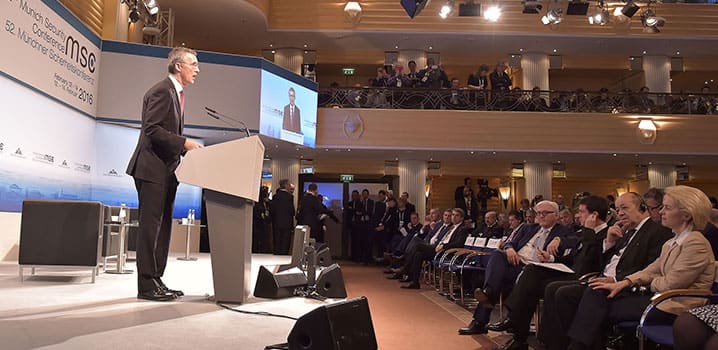
“Deterrence starts with resolve” says NATO Secretary General Jens Stoltenberg during his speech at the Munich Security Conference on 13 February 2016. © NATO
Even if Russia tends to lower the nuclear threshold and seems to envisage the possibility of an early use of nuclear weapons in a crisis or a conflict, the Alliance does not have to match this policy and to follow this dangerous path. Quite the contrary, NATO and nuclear allies can emphasise that they are responsible nuclear players that envisage nuclear weapons as weapons of ultimate resort under extreme circumstances.
NATO nevertheless ought to signal to Russia, or any other potential nuclear adversary, that the use or threat of use of nuclear weapons involving the Alliance would immediately transform the nature of the crisis. As the NATO Secretary General Jens Stoltenberg said earlier this year at the Munich Security Conference in February: “No one should think that nuclear weapons can be used as part of a conventional conflict. It would change the nature of any conflict fundamentally.”
Does NATO need to change its posture?
No radical transformation of the Alliance nuclear posture in numbers or deployment is required under current circumstances, as NATO or western nuclear weapons states do not intend to engage in a nuclear arms race with Russia or any other potential adversary. The modernisation process of the airborne Dual Capable Aircraft component should however be actively pursued by all Allies concerned, to continue to convey NATO’s resolve to maintain a credible deterrent. The B-61 nuclear bombs carried by these aircraft are not tactical weapons, as they serve a strategic purpose: deterring a major conventional or nuclear war.
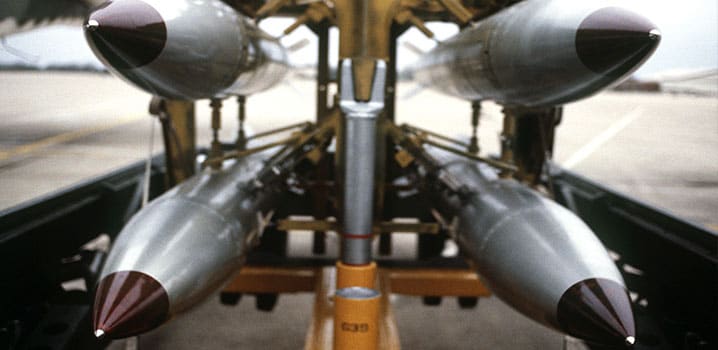
The B-61 is a variable yield nuclear bomb designed for carriage by high-speed aircraft. © US Department of Defense
The forces involved in the nuclear mission should be exercised openly and regularly, without undermining their specific nature. Such exercises should involve not only nuclear weapon states and states with Dual Capable Aircraft, but other non-nuclear Allies – once again to demonstrate unequivocally the unity of the Alliance. To put the burden of the doubt on potential adversaries, exercises should not point at any specific nuclear thresholds. But there are risks associated with the complete integration of nuclear exercises into conventional exercises: Firstly, such integration could signal a “red line” that could be tested earlier than expected. Secondly, this could go against the policies of the three nuclear Allies, which have all emphasised for decades the political nature of nuclear weapons and adhere to the principles of strict political control.
Lastly – and as acknowledged since the 1974 NATO summit in Ottawa – the three different postures of the nuclear allies (France, the United Kingdom and the United States) and the existence of multiple centres of decision both contribute to NATO’s overall deterrent. In spite of broadly converging nuclear policies, nuances do exist between Washington, London and Paris regarding their respective nuclear posture and doctrine. These nuances however contribute to the strengthening of the Alliance overall deterrent by creating additional uncertainties in the mind of any potential adversary. France’s specific position outside the Nuclear Planning Group is enshrined in history and in the central role given to the French President in nuclear decision making in all circumstances. However, France has played a central role in NATO’s nuclear debates for decades and will continue to do so, just as the French deterrent contributes to the overall nuclear deterrence of the Alliance.
Conventional and nuclear elements of deterrence and defence
NATO’s defence and deterrence posture involves an appropriate mix of nuclear and conventional capabilities but does not require mirroring capabilities and policies of Russia or any other non-NATO nuclear weapon states. In the foreseeable future, its primary objective is to establish NATO’s deterrent vis-à-vis any potential adversary. To achieve this objective, the following deterrence requirements are essential.
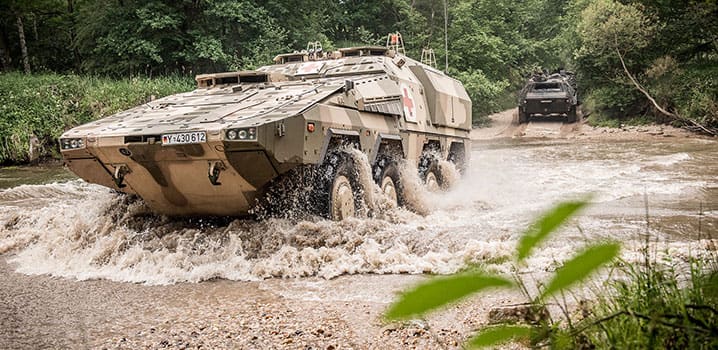
Across Europe, headquarters personnel from nine NATO member states test their responses to NATO alert orders, during the Noble Jump exercise in April 2015, to test Alliance readiness following initiatives launched at the NATO Summit in Wales in September 2014. © NATO
As decided in Wales, NATO needs to foster readiness across the board and to address specific conventional gaps when identified, such as countering ‘Anti-Access/Area Denial’ (A2/AD) threats. The role of modest tripwires was important during the Cold War, to convince the Warsaw Pact that any attack on a NATO Ally would be an attack on the Alliance. This did not involve a fail-safe conventional defence from the high north to the shores of the Mediterranean or an excessive reliance on nuclear weapons, but rather focused on the military and political credibility of the Alliance.
NATO needs to be clearer and more direct about the role nuclear weapons play in Alliance deterrence and defence. The Alliance’s language on deterrence – especially its nuclear component – has been continuously diluted in various relevant documents such as summit communiqués and strategic concepts since the end of the Cold War. This has had a detrimental effect on Alliance deterrence, making it more obscure and less specific. Even in the absence of a significant posture review, clear messaging is essential, so that potential adversaries cannot doubt the Alliance’s resolve.
In the words of nuclear strategist Hermann Kahn: “the best way to show resolve is sometimes simply to be resolved.” From that perspective, the first objective is create certainty in the mind of a potential adversary that any attack on a NATO Ally will prompt an immediate response, unleashing the full spectrum of the Alliance’s overwhelming set of military capabilities. To achieve that objective, Alliance political unity is the key to demonstrating resolve. As the Secretary General put it in his Munich speech: “Deterrence starts with resolve. It’s not enough to feel it. You also have to show it.” This is true in both the conventional and the nuclear realm.
Next steps for NATO?
Conventional and nuclear capabilities both contribute to a robust deterrent and are politically connected, even if they belong to different realms. Taking into consideration the points raised above, some policy recommendations can be derived and should, it is to be hoped, start being implemented at the Warsaw Summit.
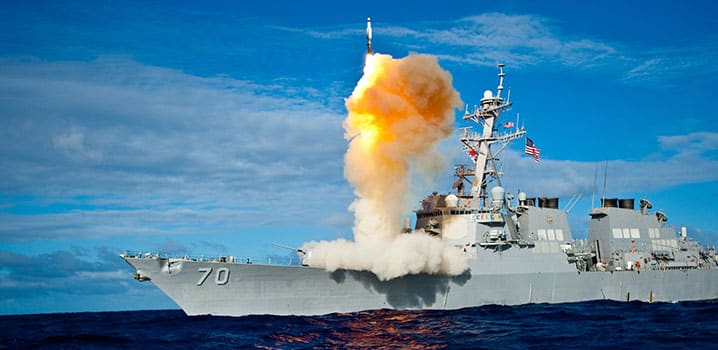
A robust set of conventional capabilities, including missile defence, is central for NATO’s deterrence and defence posture. © NATO
• A robust set of conventional capabilities (including missile defence) is central for NATO’s deterrence and defence posture, as the political credibility of an excessive reliance on nuclear capabilities could be called to question. Addressing loopholes in conventional capabilities and the continued pursuit of a significant effort to bolster defence spending that was started in Wales will play a central role in restoring NATO’s deterrence credibility. The sole reliance on nuclear capabilities is not sufficient, as potential adversaries might question the Alliance’s nuclear resolve. However, nuclear deterrence plays a central role in denying potential adversaries any escalation dominance.
• Clear messaging in Alliance policy and public documents with regard to deterrence is useful to avoid further testing of NATO’s resolve. The new strategic context does not allow for weak or ambiguous messages.
• Fostering nuclear debate within the Alliance is essential as the dramatic loss of nuclear culture, combined with the limited experience of many Allies, creates imbalances that contrast sharply with potential adversaries. This form of exercising at the political level is important for future crisis management should a crisis occur.
• Emphasising the last resort and deterrent nature of nuclear weapons could be highlighted in direct contrast with the brinkmanship postures sometimes adopted by potential adversaries. NATO should also underscore that all Allies continue to honour their international obligations and commitments, including on nuclear weapons.
• Clear warnings about the fact that the entry into play of nuclear weapons (use or threat) would dramatically alter the nature of the crisis.
NATO has a unique set of conventional and nuclear capabilities that – assuming some adaptation– should deter any potential adversaries from testing its resolve. Strategic communication regarding deterrence and defence is essential to re-establish the unequivocal assumption that the Alliance can and will act decisively should it face aggression.
NATO has provided peace and stability in the Euro-Atlantic area for decades. Nuclear deterrence played and continues to play a major role in this regard. Investing in the full spectrum of capabilities for defence and deterrence posture is a modest price to achieve this objective in the 21st century.
